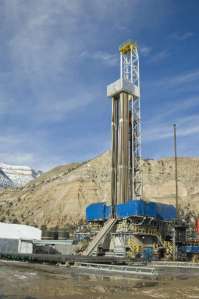
Aurora
I’m beginning to think solving this global warming thing is going to be really, really hard. We all know that the burning of carbon-intensive coal is just about the single biggest source of manmade greenhouse gas emissions. That’s why groups like the Sierra Club are fighting so hard to get America off coal—whether or not we burn the billions of tons of coal left in the ground may well decide just how unbearable the climate becomes.
So the fact that technological advances had enabled the U.S. and many other countries to tap vast new reserves of shale natural gas should be good news, at least for the climate. As a fuel natural gas is cleaner and significantly less carbon-intensive than coal, while much cheaper than most renewables, at least at this point. While some studies have tried to argue that the manufacturing process for shale gas—which includes controversial hydrofracking—means that the fuel might be dirtier over the long term than coal, the general consensus is that natural gas emits about half as much carbon over its lifecycle as coal. Therefore, cheaper shale gas than enables utilities to switch from coal generation to natural gas should slow the warming of the climate—right?
Maybe not so much. In a new study that will appear soon in the journal Climatic Change Letters, National Center for Atmospheric Research (NCAR) researcher Tom Wigley crunches the numbers and finds that switching from coal to natural gas will do little to cool the climate—in fact, depending on production methods, it might actually speed up warming. Here’s why: it’s true that coal contains far more carbon than natural gas, and when coal is burned to produce electricity, that carbon ends up in the atmosphere, intensifying the greenhouse effect. But there’s more than just carbon in coal—an average lump also contains large amounts of sulfur, ash other pollutants. When the coal is burned, those sulfates and other particles are also emitted into the atmosphere, and the smog and pollution they produce actually helps block incoming sunlight—cooling the Earth, and offsetting some of the warming effect of the carbon.
But natural gas contains far fewer such pollutants. Using complex climate modelling, Wigley found that a 50% reduction in coal and a corresponding increase in natural gas would lead to a slight increase in global warming over the next 40 years of about 0.1 F because of the reduction in the sulfates and other sunlight-blocking pollutants contained in coal. The amount of warming changed depending on how much methane might leak on average from natural gas drilling. (Natural gas is essentially methane, which is itself a powerful greenhouse gas—during the natural gas production process, small amounts of methane can escape into the atmosphere, adding to the greenhouse effect.) If the amount of methane leakage is about 2%—fairly optimistic—the switch to natural gas will keep adding to warming until the end of the 21st century, and the more methane that leaks, the longer that warming trend continues.
More from TIME: Can Shale Gas Power the World?
Says Wigley:
Whatever the methane leakage rate, you can’t get away from the additional warming that will occur initially because, by not burning coal, you’re not having the cooling effect of sulfates and other particles. This particle effect is a double-edged sword because reducing them is a good thing in terms of lessening air pollution and acid rain. But the paradox is when we clean up these particles, it slows down efforts to reduce global warming.
Frankly, it’s a drag. But Wigley’s study doesn’t mean we should give up on natural gas and keep burning coal until the sky above the U.S. resembles, well, China sky. While they may slow the process of global warming, sulfates and coal ash cause direct damage to human health, and it’s in our interest to reduce them. That’s especially true for heavily coal-using, heavily-polluted developing nations like China, for whom killer air pollution is a much more immediate threat than climate change. (As it happens, China also might have some of the largest shale gas reserves in the world—and by all accounts, they’re ready to drill.) That dash for gas isn’t likely to be blunted by fears over warming, although tighter regulations—especially on methane leakages—will be needed.
More from TIME: Another Fracking Mess for the Shale Gas Industry
But Wigley’s study is a reminder that natural gas—which is a fossil fuel, after all—isn’t a perfect panacea, now matter how hard members of the industry might wish it so. Ultimately, unless we figure out a way to magically suck carbon out of the air cheaply, we’ll need to switch to carbon-neutral fuels sooner, rather than later. Natural gas is hyped as a bridge fuel, and maybe it is—but that bridge had better be a short one.
Video from TIME: The Fuss Over Fracking
Bryan Walsh is a senior writer at TIME. Find him on Twitter at @bryanrwalsh. You can also continue the discussion on TIME’s Facebook page and on Twitter at @TIME


